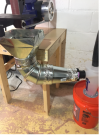I'm also a hobbyist, just getting started in all this

Of course using a vacuum cleaner is better than nothing. I did try it, with my collection hood, and honestly I'd prefer a large bucket with water instead. Sure it sucked away the dust that fell/shot into the hood, but it did not
make the dust fly in there well enough.
I too am just starting out and from different observations I have too come to the conclusion that a large bucket is perhaps even better because usually the suction funnel is limited in size and you see sparks flying by it. A very big bucket, on a stool just below the grinder, filled with a bit of water will catch all of the the sparks which fly down.
I put a drop of dish soap in the water which will break the surface tension of the water and lead to better absorption of the dust.
In my observation there are three forms of grinder dust: the sparks flying down, the sparks that are pulled in a circle with the belt and fly against the apron, and the very fine dust which is airborne for hours and settles down all across the room.
The last is the hardest to deal with and I did a lot of thinking of what to do about it since there are quite a few other things in my workshop and I did not want to have dust everywhere.
My inspiration was this video:
youtu.be/X8cNeuF_78k
But I went one step further and built a dust cabin around the grinder:
The foundation which holds everything together is a plywood roof and on the sides there are plexiglass windows and a plexiglass sliding door.
Connected to the wooding housing around the grinder is a funnel which is connected to the cyclon extractor outside of the cabin (in the lower right of the photo) which is connected to a Nilfisk Attix shop vac with a Hepa Filter.
This set up works really well and there is no dust to be found even inside of the cabin after a grinding session (except for a bit of dust directly around the grinder inside wooden housing).
Some more photos:
The plexiglass sliding door has an aluminum angle attached to the plywood strip on top of it which hooks
a wooden angle on top of the roof. A wood sliding compound makes it open and close easier.
On the bottom is an aluminium angle which guides the door.
Another big recommendation are the "true light" tubes which have the spectrum of sun light and are completely flicker free. They make a very nice daylight atmosphere and the light has positive effects on mental and body health. It also merges perfectly with any incoming light from outside. The lowest photo is almost entirely lit by two tubes, a small bulb is on the top left which makes a warmer light and a very small top window is at the top right and the light coming from it merges perfectly with the tube light from the top.











